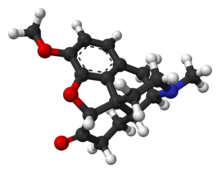Hydrocodone
 |
|
 |
|
| Clinical data | |
|---|---|
| Trade names | Vicodin, Norco, Lortab, Zohydro ER |
| AHFS/Drugs.com | Micromedex Detailed Consumer Information |
| MedlinePlus | a601006 |
| Pregnancy category |
|
| Dependence liability |
Severe / high |
| Routes of administration |
Clinical: oral Others: intranasal, rectal |
| ATC code | |
| Legal status | |
| Legal status |
|
| Pharmacokinetic data | |
| Bioavailability | Oral: 25% |
| Protein binding | Low |
| Metabolism | Hepatic: CYP3A4 (major; to norhydrocodone), CYP2D6 (minor; to hydromorphone) |
| Onset of action | 10–20 minutes |
| Biological half-life | Average: 3.8 hours Range: 3.3–4.4 hours |
| Duration of action | 4–8 hours |
| Excretion | Renal |
| Identifiers | |
|
|
| Synonyms | Dihydrocodeinone |
| CAS Number | |
| PubChem CID | |
| IUPHAR/BPS | |
| DrugBank | |
| ChemSpider | |
| UNII | |
| KEGG | |
| ChEBI | |
| ChEMBL | |
| ECHA InfoCard | 100.004.304 |
| Chemical and physical data | |
| Formula | C18H21NO3 |
| Molar mass | 299.368 g/mol |
| 3D model (Jmol) | |
|
|
|
|
| What is this drug for? | |
|---|---|
| treatment of severe, chronic pain that requires around-the-clock opioid treatment | |
| Who might consider taking it? | |
| Adults who need opioid treatment but who find alternative treatments to be inadequate | |
| Who should not take it? | |
|
|
| What other choices are there? | |
|
Hydrocodone, also known as dihydrocodeinone, is a semi-synthetic opioid synthesized from codeine, one of the opioid alkaloids found in the opium poppy. It is a narcotic analgesic used orally for relief of moderate to severe pain, but also commonly taken in liquid form as an antitussive/cough suppressant.
Hydrocodone is prescribed predominantly within the United States, with the International Narcotics Control Board reporting that 99% of the worldwide supply in 2007 was consumed in the United States. Several common imprints for hydrocodone are V4212, M365, M366, M367.
Hydrocodone is used to treat moderate to severe pain and as an antitussive to treat cough. In one study comparing the potency of hydrocodone to that of oxycodone, it was found that it took 50% more hydrocodone to achieve the same degree of miosis (pupillary contraction). The investigators interpreted this to mean that oxycodone is about 50% more potent than hydrocodone.
However, in a study of emergency room patients with fractures, it was found that an equal amount of either drug provided about the same degree of pain relief, indicating that there is little practical difference between them when used for that purpose. Some references state that the analgesic action of hydrocodone begins in 20–30 minutes and lasts about 4–8 hours. The manufacturer's information says onset of action is about 10–30 minutes and duration is about 4–6 hours. Recommended dosing interval is 4–6 hours.
Hydrocodone is available in a variety of formulations for oral administration:
Hydrocodone is not available in parenteral or any other non-oral forms.
Common side effects of hydrocodone are nausea, vomiting, constipation, drowsiness, dizziness, lightheadedness, anxiety, abnormally happy or sad mood, dry throat, difficulty urinating, rash, itching, and narrowing of the pupils. Serious side effects include slowed or irregular breathing and chest tightness.
...
Wikipedia
